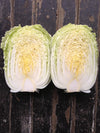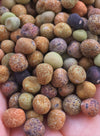Parsnip, 'Schleswiger Schnee'
(Pastinaca sativa) Parsnips have an integral place in our winter kitchen: roasted as a side to slow-cooked lentils or risotto, pureed into a creamy, nutty soup, and even paper-thin atop pizzas. Their warming, sweet, earthy flavor is the perfect match for the hibernation time of year. Schleswiger Schnee came from a breeding program at Christiansen Biohof in northern Germany, part of a movement in collaboration with organizations like Saat:gut and Bioverita to establish high-market quality OP seed bred under organic conditions. Beautiful and shapely tapered white roots sweeten after frost. Good uniformity and storage qualities.
120 days. AV
Packet: 1g (~ 250 seeds)
Product Code: PAR-SS-pkt
Availability:In stock
| Translation missing: en.products.general.options | Translation missing: en.products.general.qty | Translation missing: en.products.general.qty |
|---|---|---|
|
$4.50 |
||
|
$7.00 |
||
|
$20.00 |
Growing Info
SOWING:
Seeds can be sown in early spring (April) and into late July. Direct seeding is strongly recommended.
Note: Parsnips prefer cooler ambient temperatures, deep, well-drained, light, sandy, and loamy soils with a neutral to slightly acidic (6-7) pH, and an even watering schedule (do not let the soil dry out before emergence!).
PLANTING DEPTH:
1/2"
SPACING:
2-3" between plants in rows 18-24" apart.
EMERGENCE:
21 days @ soil temp 55-75F and even watering. Temperatures over 80F may inhibit germination.
LIGHT:
Full sun to part shade
FERTILITY:
Moderate to high. Parsnips prefer well-prepared, fertile, and evenly moist soil (not too wet). Excess N leads to luscious greens and poor roots. Avoid excess N. as it may lead to hairy and/or forked roots. Aim for a neutral to slightly acidic soil with a pH between 6.0 and 7.0.
ADDITIONAL NOTES:
Remember that parsnips prefer cooler temperatures, even water, aerated soil, and space. Keep em weeded!
If you find that your parsnips are producing hairy forked roots, your soil may be too high in N.
Try to avoid growing parsnips in a new, previously grassy area, as wireworms will visit!
Use floating row cover to deter carrot rust flies and aim for a 3-year rotation to avoid blight.
Considerably sweeter after frost, but harvest before a freeze.




